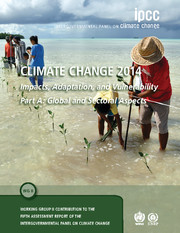 Climate Change 2014 – Impacts, Adaptation and Vulnerability: Part A: Global and Sectoral Aspects
Climate Change 2014 – Impacts, Adaptation and Vulnerability: Part A: Global and Sectoral Aspects Technical Summary
Published online by Cambridge University Press: 05 January 2015
Summary
ASSESSING AND MANAGING THE RISKS OF CLIMATE CHANGE
Human interference with the climate system is occurring (WGI AR5 SPM Section D.3; WGI AR5 Sections 2.2, 6.3, 10.3 to 10.6, 10.9). Climate change poses risks for human and natural systems (Figure TS.1). The assessment of impacts, adaptation, and vulnerability in the Working Group II contribution to the IPCC's Fifth Assessment Report (WGII AR5) evaluates how patterns of risks and potential benefits are shifting due to climate change. It considers how impacts and risks related to climate change can be reduced and managed through adaptation and mitigation. The report assesses needs, options, opportunities, constraints, resilience, limits, and other aspects associated with adaptation. It recognizes that risks of climate change will vary across regions and populations, through space and time, dependent on myriad factors including the extent of adaptation and mitigation.
Climate change involves complex interactions and changing likelihoods of diverse impacts. A focus on risk, which is new in this report, supports decision making in the context of climate change and complements other elements of the report. People and societies may perceive or rank risks and potential benefits differently, given diverse values and goals.
Compared to past WGII reports, the WGII AR5 assesses a substantially larger knowledge base of relevant scientific, technical, and socioeconomic literature. Increased literature has facilitated comprehensive assessment across a broader set of topics and sectors, with expanded coverage of human systems, adaptation, and the ocean. See Box TS.1.
Section A of this summary characterizes observed impacts, vulnerability and exposure, and adaptive responses to date. Section B examines future risks and potential benefits across sectors and regions, highlighting where choices matter for reducing risks through mitigation and adaptation. Section C considers principles for effective adaptation and the broader interactions among adaptation, mitigation, and sustainable development.
Box TS.2 defines central concepts. To convey the degree of certainty in key findings, the report relies on the consistent use of calibrated uncertainty language, introduced in Box TS.3. Chapter references in brackets indicate support for findings, figures, and tables in this summary.
- Type
- Chapter
- Information
- Climate Change 2014 – Impacts, Adaptation and Vulnerability: Part A: Global and Sectoral AspectsWorking Group II Contribution to the IPCC Fifth Assessment Report, pp. 35 - 94Publisher: Cambridge University PressPrint publication year: 2014
- 90
- Cited by
